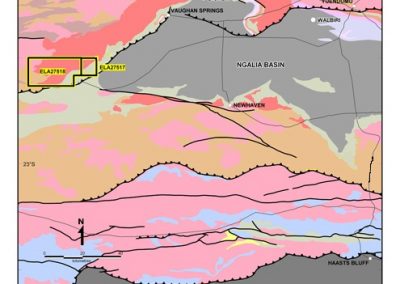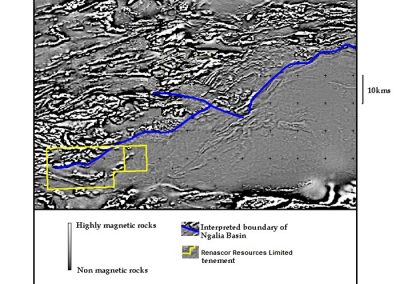Ngalia Basin
The Ngalia Basin Project comprises of two exploration licence applications 200–400 km west-north-west of Alice Springs. Together the properties cover a combined area of about 467 km2 on the northwest margins of the Neoproterozoic to Palaeozoic Ngalia Basin, one of several intracratonic Central Australian Basins showing similar geological evolution.
Figure 1. Ngalia Basin Project
Basement source rocks of the Arunta Province include radiogenic Palaeoproterozoic to Mesoproterozoic granites and metasedimentary sequences. These basement rocks are overlain by Neoproterozoic to Carboniferous sediments of the Ngalia Basin, with the basin margin providing the targeted sandstone of the Mount Eclipse Formation that hosts uranium deposits, like the nearby Bigrlyi uranium deposit. Exploration in the Ngalia Basin Project is therefore focused on targeting both sandstone hosted uranium deposits along the margin of the basin and shear hosted uranium within the basement rocks. Key exploration features include:
• Geophysical surveys suggest extension of basin margin into project area. Regional aeromagnetic data indicates that the basin margin may extend westerly into the project tenements. See Figure 2. This area has experienced little recent exploration for uranium.
• Uranium mineralisation in area. The region is endowed with several uranium deposits, including Bigrlyi and Walbiri within the Ngalia Basin, the Nolans Bore uranium and rare earth deposit in metasediments of the Arunta Province and the Napperby uranium deposit hosted within Tertiary sediments. See Figure 1. Renascor believes that nearby radiogenic basement rocks sourcing uranium input into the Ngalia Basin sediments are geologically analogous to the northern Flinders Ranges and Frome Embayment, where the breccia/shear hosted Mt Gee deposit within basement rocks sources the Four Mile/Beverley sandstone hosted deposits.
• Low cost exploration. The Ngalia Basin benefits from a shallow cover sequence, permitting the use of inexpensive air core drilling as part of an initial first pass exploration program.
Figure 2. Ngalia Basin Aeromagnetic Image, showing interpreted basin margin
Upon the granting of these licenses, the proposed work program involves reconnaissance aircore drilling traverses to identify geochemical anomalies and geological hosts associated with sandstone hosted roll-front uranium targets and shear hosted mineralisation.


